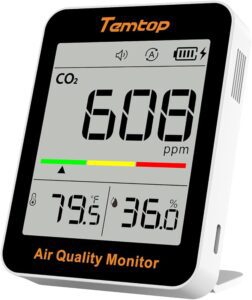TIPS AND TRICKS
CLEAR THE AIR!

CLEAN AIR CLASSROOM

If you run a workshop space or are teaching, you might want to clear the air about… the air.
A few years ago I was teaching a class in Ljubljana, Slovenia for IGLU IMPROVISATION. Vid Sodnik – that wild and wonderful Slovenian – brought me into one of their three studios and said, “this is the place you will be teaching”. It was a smallish studio that was bright and comfortable.
I looked around and on the wall I saw what I thought was the temperature adjustment device. I glanced at it and it showed the number 450… That couldn’t be right.
I asked Vid about it and he told me that it was the air monitor. He explained that the little device measured indoor air quality (IAQ). When the number got too high, they would make sure to open the windows and air out the place.
At first, I wasn’t too sure what to make of that. I knew an open window felt good in a stuffy room near the end of the day but I didn’t consider the value of the little monitor as more than a geeky gadget..
So, I forgot about it until years later when I was researching information on ways to make the brain work better for improvisers. A topic that cam up a lot was AIR QUALITY.
How important could small shifts in the air be in a classroom setting?
There are tiny particulates in the air that have an almost immediate impact on us. Carbon monoxide, Ozone, and Radon can be deadly and harmful for example. Some concentrations of those usually found indoors and are hopefully in acceptable levels.
Healthy work and play spaces won’t typically have issues with these more deadly substances. But then there’s the stuff we bring into the rooms with us.
CO2 is what we breathe out. When there’s too much C02 in the room, our brains aren’t going to get the good stuff that keeps them functioning optimally. High C02 levels have a major impact on cognitive functions. We don’t think clearly. We are tired and our focus goes out the window.
Years later, when I taught another class in IGLU’s new workshop space, there were more people and there was a newer looking air quality monitor.
I decided to pay attention to the tiny machine during the class. Sure enough after we had been moving around and breathing a bit- which is hard not to do – the number on the device shot up to 1300. I hadn’t noticed any change but sure enough people began showing that lazy, sluggish quality in the middle of the day. Their brains seemed to be slow to catch on to new instructions as well.
Vid checked the monitor, noticed the levels were up, and opened the windows. It wasn’t long after that small fix that I noticed everybody returning to a better state. This was a consistent pattern through the class. Vid would catch the students before they lost focus and reverted to Zombie states.

I bought a little “TEMTOP” air quality monitor ( about 40 dollars Canadian) when I got back home. ( I’m not sponsoring the company) I bring it to classes just to keep track of the air. I’ve noticed that people get more tired and need more breaks when the monitor is reading high levels of C02. It’s a great reminder to get fresh air into the class before there’s trouble
A healthy room supports healthy minds and improve the workshop experience. You might not want to get one of these inexpensive devices but you should at least considering the dirty air out of the room more often,




0 Comments